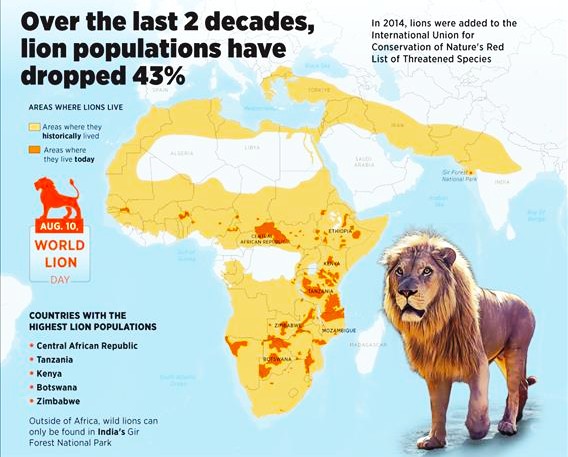King of the Jungle in Danger: Lions in the Wild facing extinction all over Africa
On World Lion Day 2025, it was reported that Africa’s most iconic species are already extinct in 26 of the 48 African countries, with wild populations surviving in only 7 percent of their historic range.
According to Wild Africa, Habitat loss, human-wildlife conflict, poaching, and snaring are among the key drivers of this crisis.
Tanzania, being home to the largest lion population in Africa, plays a crucial role in the survival of this majestic species.
Researchers estimate the number of lions in Tanzania to be around 14,000.
Protecting lions in Tanzania is not only vital for the species itself but also for the ecological balance and cultural heritage that lions represent across the continent.
For centuries the African lion has symbolised strength, courage and leadership, deeply rooted in African culture, identity and spirituality.
Wild Africa is emphasising the urgency of protecting wild lions through integrated solutions that support both the animals and local communities.
According to LionAid’s 2025 Synthesis of Lion Numbers in Africa, the population of wild lions is perilously low.
Although exact numbers are difficult to confirm, an estimated 13,014 lions are left in eastern and southern Africa, and only 342 in western and central Africa—regions where populations are genetically distinct and under even greater threat.

Separate data compiled by the International Union for Conservation of Nature (IUCN) List of Endangered Species confirm that lion populations continue to decline.
The species recovery status is ‘Largely Depleted’ and they have a recovery score of just 23 percent to 33 percent.
The primary cause is habitat loss
Lions once roamed from Europe to the southern tip of Africa and from West Africa east to India, but human settlement expansion, agriculture, infrastructure, and land-use have drastically reduced their range to only 7 percent.
Habitat degradation also affects the availability of wild prey.
A recent study published in Conservation Science and Practice found that prey-depleted ecosystems are a major contributor to lion population declines.
Other threats include; Human-wildlife conflict, where lions are often killed to protect livestock or in retaliation for perceived threats.
There is also the issue of poaching in which the Lions are hunted for body parts including their bones, claws, teeth, fat and skin, used in traditional medicine, ornaments, or sold in illegal markets.
In some cases, the non-selective wire snares, intended for bush meat, often trap and injure or kill the lions. Snaring also contributes to the loss of prey.
Lions are critically important for the health and balance of entire ecosystems. As a keystone species, their protection helps sustain the diversity of life – from plants and trees to the animals that depend on them.
Additionally, lions are among the most sought-after wildlife by safari tourists.
Wildlife tourism contributes 8.5 percent of Africa’s GDP with around 80 percent of international visitors citing wildlife as their primary reason for traveling to the continent.
With mounting threats and concerning recovery rates, it has never been more important to implement effective conservation efforts to protect Africa’s wild lions.
An integrated approach that prioritises habitat preservation, community engagement, improved law enforcement against wildlife crimes, and sustainable tourism can turn the tide for these animals.
The public can play a vital role too, from reporting wildlife crime and conserving natural habitats to visiting national parks, where entry fees directly support rangers and conservation projects.
World Population Review says there are around 30,000 lions around the globe
Categorized as a vulnerable population, the International Union for Conservation of Nature (IUCN) estimates somewhere between 23,000 and 39,000 lions remain in the wild.
However, other conservation groups have placed estimates closer to only 20,000.
Tanzania in eastern Africa has the highest number of wild lions worldwide, roughly 14,500. Most of these majestic cats live in Tanzania’s National Parks and Preserves. Another country with a significant lion population is South Africa – 3,284 animals.
An estimated 3,063 wild lions can be found in Botswana, while Kenya and Zambia each have approximately 2,500 animals within their borders.
The countries of Zimbabwe, Mozambique, Nambia, and Angola have a combined total of 4,600 lions. Other countries with only a few hundred wild cats each include Uganda, Ethiopia, Sudan, and Cameroon.

